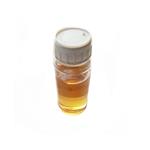- 10-Bromodecanol
-

- $0.00 / 1KG
-
2025-10-21
- CAS:53463-68-6
- Min. Order: 1KG
- Purity: 99%
- Supply Ability: 20 mt
- 10-Bromodecanol
-

- $0.00 / 25KG
-
2025-09-11
- CAS:53463-68-6
- Min. Order: 1KG
- Purity: 99%
- Supply Ability: 50000KG/month
- 10-Bromodecanol
-

- $40.00/ kg
-
2025-04-15
- CAS:53463-68-6
- Min. Order: 1kg
- Purity: 99%
- Supply Ability: 5000kg/week
|
| | 10-Bromodecanol Basic information |
| | 10-Bromodecanol Chemical Properties |
| Boiling point | 165-169 °C/10 mmHg (lit.) | | density | 1.19 g/mL at 25 °C (lit.) | | refractive index | n20/D 1.476(lit.) | | Fp | >230 °F | | storage temp. | Inert atmosphere,Store in freezer, under -20°C | | solubility | Chloroform (Sparingly) | | form | Liquid | | pka | 15.20±0.10(Predicted) | | color | Clear yellow | | Water Solubility | It is miscible with water. | | BRN | 1738593 | | Stability: | Moisture Sensitive | | InChIKey | LGZMUUBPTDRQQM-UHFFFAOYSA-N | | CAS DataBase Reference | 53463-68-6(CAS DataBase Reference) | | EPA Substance Registry System | 1-Decanol, 10-bromo- (53463-68-6) |
| Hazard Codes | Xi | | Risk Statements | 36/37/38 | | Safety Statements | 26-36 | | WGK Germany | 3 | | TSCA | Yes | | HS Code | 29055900 |
| | 10-Bromodecanol Usage And Synthesis |
| Chemical Properties | Clear yellow liquid | | Uses | 10-Bromo-1-decanol is used as an important raw material and intermediate used in organic Synthesis, pharmaceuticals, agrochemicals and dyestuff. It was also used in the synthesis of (11Z,13Z)-11,13-hexadecadienal, the female sex pheromone of the navel orangeworm (Amyelois transitella). | | Uses | 10-Bromodecanol can be used to synthesize rotaxane dendrimers. It can also be used to synthesize J2326, a molecule that induces neurite outgrowth in neuronal cells. | | Definition | ChEBI: 10-Bromo-1-decanol is a primary alcohol. | | Synthesis | General procedure for the synthesis of 10-bromo-1-decanol from 1,10-decanediol: 1,10-decanediol (10 g, 57.47 mmol) was dissolved in toluene (600 mL) and transferred to a 1 L two-necked, round-bottomed flask fitted with a Dean-Stark separator. 48% hydrobromic acid (7.15 mL, 63.21 mmol) was slowly added to the reaction system and subsequently heated to reflux for 16 hours. After completion of the reaction, it was cooled to room temperature and the reaction mixture was washed sequentially with 1 N hydrochloric acid, 2 M aqueous sodium hydroxide, deionized water and saturated saline. The organic phase was separated, dried with anhydrous sodium sulfate, filtered and concentrated under reduced pressure. The crude product was purified by silica gel column chromatography (eluent: 15% ethyl acetate/hexane) to afford 10-bromo-1-decanol as a colorless transparent oil (12.7 g, 93% yield). Thin layer chromatography (TLC) Rf = 0.45 (unfolding agent: 20% ethyl acetate/hexane); 1H NMR (500 MHz, CDCl3): δ 3.63 (t, J = 5.8 Hz, 2H), 3.39 (t, J = 6.8 Hz, 2H), 1.85 (m, 2H), 1.56 (m, 2H), 1.42 (m, 2H), 1.38- 1.27 (m, 10H); 13C NMR (125 MHz, CDCl3): δ 62.9, 33.9, 32.7, 32.6, 29.3, 29.2, 29.2, 28.6, 28.0, 25.6; infrared spectra (neat sample): νmax 2927, 2856, 1738, 1593, 1449, 1367, 1241 cm-1; high-resolution mass spectrum (ESI): calculated value C10H22BrO [M + H]+ 237.0854, measured value 237.0845. | | References | [1] Tetrahedron, 2015, vol. 71, # 7, p. 1058 - 1067
[2] Bioorganic and Medicinal Chemistry, 2010, vol. 18, # 3, p. 1083 - 1092
[3] ACS Medicinal Chemistry Letters, 2010, vol. 1, # 6, p. 273 - 276
[4] Bioorganic and Medicinal Chemistry, 2011, vol. 19, # 1, p. 567 - 579
[5] Patent: EP1818336, 2007, A1. Location in patent: Page/Page column 7 |
| | 10-Bromodecanol Preparation Products And Raw materials |
|